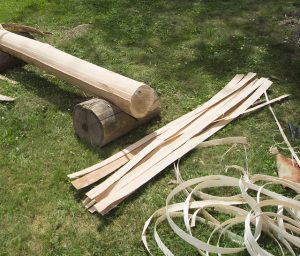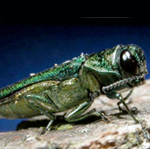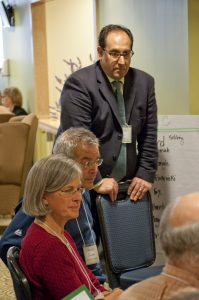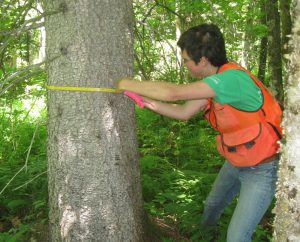Preparing for the Worst: Taking on the Emerald Ash Borer
By JOE RANKIN

The process of making a traditional Native American ash basket starts in the woods. It begins with finding a good stand of black ash trees. Then selecting the best for harvesting. Pounding the debarked boles to release the growth rings and make splints. Then splitting the splints. Only then does weaving begin.
The tree determines the quality of the material and the beauty of the basket itself. Black ash, Fraxinus nigra, is also known in Maine as brown ash. It grows throughout the state, but it makes up a small percentage of the forest, maybe 2 percent. And of those trees, only a fifth will be high quality “basket trees.”
That’s why most Maine Indian basketmakers keep the locations of their black ash stands a secret. As you would a good fishing spot. Or a bountiful mushroom spot. Or even a place where you can drink in a beautiful view and enjoy solitude.
University of Maine graduate student Kara Lorion accompanied half a dozen basketmakers from Maine’s four Wabanaki tribes into the woods, sometimes stepping from the road directly into a grove of ash, other times following a deer trail for a half hour to reach the trees. Once there, she talked to them about how they find trees and determine which ones to use. And she videotaped the interviews.
“We generally let the harvester lead the interview,” she said. “But we specifically asked about the differences in trees, why you would use this tree and why not that one. One person also pounded a tree for us and showed us how to process it,” she said.
Lorion knew that these ash tree harvesters were allowing her unprecedented access to an important, private part of their lives and their cultural tradition, and said she felt privileged to accompany them. “I learned a lot about the tree itself,” she said. “During our field work we took measurements and looked at other trees, but the harvesters looked at things that I wouldn’t even see: at how the tree grows, where it’s growing, what types of soils it’s growing in and what types of land formations are nearby, what other species are growing there.”

These videos aren’t just an academic exercise. They’re an effort to document the usually unseen details of a traditional art that could very well be imperiled. The emerald ash borer, a tiny, metallic green beetle from China, already has killed tens of millions of ash trees in North America. It has been found in 22 states, including New Hampshire, and two Canadian provinces, one of them Quebec. Efforts to contain the borer have been unsuccessful and there is no reason to think the insect won’t eventually show up in Maine.
If black ash is wiped out and the art of ash basketry fades from the collective memory of Maine’s native tribes, Lorion’s videos will be a legacy of knowledge that could be accessed generations hence if new options are developed to re-establish the species as part of the forest landscape.
The video archive is part of a multi-year and multi-pronged project by the Senator George Mitchell Center for Sustainability Solutions to help the state and the Penobscot, Passamaquoddy, Micmac, and Maliseet tribes deal with the threat.
The project began in 2009 and much of the first five years was spent building a network of people and agencies to grapple with the inevitable issues and questions of how to prepare for the invasion of the borer, said Darren Ranco, a professor of anthropology and chair of Native American Programs at the University of Maine, who is also a member of the Penobscot Nation.
Part of building a statewide team was bringing together a variety of people, ranging from tribal natural resource professionals to state officials; members of the Maine Indian Basketmakers Alliance to the federal Animal and Plant Health Inspection Service (APHIS). Their periodic gatherings, which included presentations by experts, were key to cementing relationships and building trust for what could be seen as a rapid response team, said Ranco.
“I was impressed all along by the people who showed up. From 25 to 45 people came to all of the meetings. Just the generosity and willingness to listen to each other was special,” Ranco said.
The group has done “tabletop exercises” — war games, so to speak — in how to respond to the borer’s arrival. The informal relationships will be formalized with memoranda of understanding between the various agencies, Ranco said.

A Black Ash Symposium was held at the University of Maine Nov. 5-7. The symposium focused on the biology and ecology of the species throughout North America. The aim was to clarify what is known about the tree and what needs to be learned to make sure it survives in the landscape.
Dave Struble, the Maine state entomologist who participated in the meetings already held, said they have been productive. The group had frank discussions about thorny issues such as quarantines and who would survey for the borer on tribal lands. “It led to a broader thought process,” Struble said. “I think it’s been productive. It provided neutral ground to discuss things…if the borer was found in Maine tomorrow the communications would kick right in for all the things that have to happen.”
Jennifer Neptune, the executive director of the Maine Indian Basketmakers Alliance, said the Mitchell Center’s effort to bring affected parties together to work on the issues before they arise has left Maine’s Indian tribes “in a much better place” than they would have been otherwise. And the education efforts have helped as well. “The worst thing is fear of the unknown.”
David Hart, the director of the Mitchell Center and a professor of biology and ecology at UMaine, said the ash borer project fits into the Center’s mission to “tackle multi-faceted problems that involve intersecting environmental, social, cultural, and economic issues. It’s exciting to see teams of students and faculty learning from our partners, and vice versa. This is exactly the kind of collaboration that can generate innovative solutions to complex problems.”
The project received its initial funding from the National Science Foundation’s Experimental Program to Stimulate Competitive Research (EPSCoR ), and then received another grant from the Elmina B. Sewall Foundation for additional work, much of which will be devoted to what Ranco likes to call “adaptations” to the reality of a voracious insect with a tremendous appetite for a tribal cultural icon. Among them: the video project, computer modeling of black ash habitat and mapping of black ash stands, getting permission for tribal basketmakers to access ash on private property, collection and long-term storage of ash seeds, and exploring the possibilities for extended storage of ash logs.
While the videoing of ash harvesters talking about tree environment, selection, harvesting and processing has largely been completed, the videos need to be edited, said Lorion. And answers must be found to some vexing practical and ethical questions: how do you construct the archive, who has access to it, who owns it, and how do you ensure, with the nearly constant changes in technology, that tribal members generations in the future will be able to use it.
Suzanne Greenlaw, a graduate student in the Mitchell Center and UMaine’s School of Forest Resources, a member of the Maliseet tribe and a maker of ash baskets herself, is one of the people working on computer models that could be used to predict where in the state basket quality black ash is likely to grow.
She said she started the process by interviewing tribal ash harvesters about how they go about scouting out the trees. Theirs is kind of a “total landscape” knowledge, Greenlaw said.
Black ash generally prefers moist, rich, well-drained soils. Floodplains of rivers are ideal; islands in the rivers even better. The tree is often found in the company of red maples. Harvesters usually follow a river or stream until they find one stand, then go up or downstream to find the next. But “in a stand of 50 trees they’ll choose only two or three trees to harvest,” she said. Basketmakers look not just to see that the tree is growing straight and true, but what plants grow in the understory, what other trees are nearby, what the soils are like. All of that tells them whether, once the bole is pounded and its growth rings separate into splints, that they will be good basketmaking material.
Turning that sort of traditional expertise into scientific numerical values that can be plugged into a computer model is, well, “there’s a lot to it,” Greenlaw said. She’s looking at using soil types, site characteristics, drainage, forest community, elevation, distances to fresh water sources and so on. After the model is created there’s the need to ground-truth it, to see if it does what it’s supposed to do. “We don’t want to send basketmakers out to locations that aren’t good ash, because that’s a waste of their time and money,” she said.
Greenlaw is also working with J.D. Irving, one of Maine’s largest landowners, to allow native harvesters the ability to collect natural materials on the company’s lands, not just black ash for basketry, but birchbark and traditional medicinal plants.
Forest stewardship certification mandates that landowners take the needs of indigenous cultures into account and reach out to them, but all too often that communication doesn’t lead anywhere, said Greenlaw. She sees herself as essentially as an intermediary between the tribes and Irving to set up a permitting system so tribal members have access to Irving lands. If that works out it could be expanded to other companies that own millions of acres of the Maine woods, she said.
Ranco said locating and getting access to black ash stands is “going to be a critical element” in efforts to ensure that tribal basketmakers have the ability to ply their traditional craft for as long as possible in the face of an emerald ash borer onslaught.
The computer modeling and mapping, for instance, is a prerequisite when it comes to another prong of the project — seed saving. Whether the borer destroys all black ash in the region or not, it is likely to drastically reduce the tree’s genetic diversity. The idea is to save seeds that could be held in seed banks throughout the country against the day when the borer has died out or an effective biocontrol is found. That’s likely to be a while.
The project has already gotten tribal young people involved in seed collection. The mapping program is essential to directing those efforts, including focusing them on particular stands with a high concentration of suitable “basket trees.”

Another facet of the project is finding out whether it’s possible to create a stockpile of raw material that could last for years, perhaps decades. Among the possibilities are freezing logs or submerging them in water, Ranco said. He said the team will brainstorm ideas and subject the best ones to further research. It has long been known that long submerged logs can be retrieved and turned lumber or pulp for paper. There are companies in Maine that market products made from wood mined from lakes. However, whether logs submerged for decades would still produce splints usable for basketmaking is an open question that has not been researched. Research has shown that submersion will kill the borer pupae. Finished splints can be stored for decades, with the only damage discoloration from light, Ranco said.
Ranco is confident that there’s still time to come up with some answers, though the seemingly unstoppable beetle virtually has its foot on Maine’s threshold. “It’s not necessarily a game-over scenario” when the beetle is found in Maine, he said. It’s likely that the tragedy will “play out over decades.”
No one is certain exactly what will happen when the borer enters Maine’s vast forests — and Struble, the state entomologist, says that’s a when, not an if. Its advance could be slowed by the fact that the three ash species that grow in Maine — white, green and black — make up a smaller percentage of the forest in Maine, and are much more dispersed through the landscape than, say, in Michigan, where huge stands of ash are common. Scientists say the borer is unlikely to kill every ash and that certainly won’t happen overnight.
“I think because we’ve done the scenarios that people will be prepared. there won’t be as much emotional response. People know this is a long process. They know what studies will happen and how they will participate in them and how to communicate,” said Ranco. “It’ll be a sad day when we find it here, for basketmakers particularly, but we will just enact what we’ve been working on.”
In a way it’s like fighting cancer. The outcome may be uncertain, but “buying time to fight against an invasive pest actually does work. There are scenarios where nature finds a way,” said Ranco. “It matters. It matters to me personally if we can make it 20 years, versus five years. That’s still worth it. The traditions will live on beyond the emerald ash borer. I’m not willing to give up on it.”
Writer Joe Rankin lives in New Sharon; his 70-acre woodlot includes quite a few ash trees.
Mobilizing to Fight the Emerald Ash Borer
Project Resources
